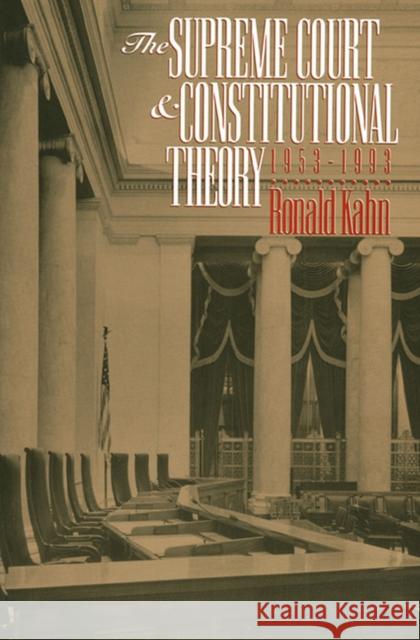The Supreme Court and Constitutional Theory, 1953-1993 » książka
topmenu
The Supreme Court and Constitutional Theory, 1953-1993
ISBN-13: 9780700607112 / Angielski / Miękka / 1994 / 328 str.
Ronald Kahn greatly revises our understanding of Supreme Court decision making and its relation to constitutional theory in the eras of chief justices Earl Warren, Warren Burger, and William Rehnquist. In the process, he refutes the longstanding stereotypes of an activist Warren Court trying to legislate individual rights and of a visionless Burger Court hiding in its predecessor's shadows.
Kahn contends that the dominant view of the Supreme Court as just another political institution is incorrect. That view depicts an unprincipled court wavering before external politics and public opinion or bending to the political agendas of individual justices. Kahn counters that justices throughout the postwar epoch, while well aware of the political environment, have consistently relied upon legal precedent and constitutional principles-especially in cases relating to individual rights and popular sovereignty. The Burger Court in particular, Kahn argues, had both a coherent vision and a highly complex understanding of malfunctions in the American polity and of fundamental rights in the Constitution. He cites as salient examples the Burger Court's controversial decision in Roe v. Wade and its decisions regarding gender equality, religious freedom, and the right to education of all children, even illegal aliens. He suggests that this same sensitivity, despite enormous popular and political pressures, has been demonstrated by the Rehnquist Court's decision in Planned Parenthood of Southeastern Pennsylvania v. Casey (1992). Kahn effectively reveals how the Supreme Court is influenced by its ongoing dialogue with scholars, judges, journalists, and others who debate the connections between constitutional law and democratic government. His critique of works by such prominent theorists as Robert Dahl, Martin Shapiro, Vincent Blasi, Anthony Lewis, Archibald Cox, Alexander Bickel, Herbert Wechsler, John Hart Ely, and Laurence Tribe, among others, provides valuable insights into this exchange between the court and its "interpretive community." His chapter on the new civic republicans like Michael Perry, Mark Tushnet, and Sanford Levinson, is especially provocative in its analysis of a potentially more productive guide for jurisprudence in the 1990s. Combining theoretical sophistication with a fundamental comprehension of our nation's political institutions, Kahn's study should help demystify for scholars and students alike the workings of the Court and its place in our democracy.










